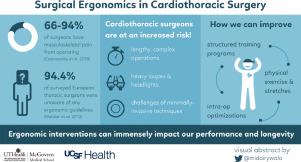Seminars in Thoracic and Cardiovascular Surgery ( IF 2.5 ) Pub Date : 2021-09-29 , DOI: 10.1053/j.semtcvs.2021.09.015 Mohammed I Dairywala 1 , Saurabh Gupta 2 , Michael Salna 3 , Tom C Nguyen 4

|
With the high prevalence of musculoskeletal pain in surgeons and interventionalists, it is critical to analyze the impact of ergonomics on cardiothoracic surgeon health. Here, we review the existing literature and propose recommendations to improve physical preparedness for surgery both in and outside the operating room. For decades, cardiothoracic surgeons have suffered from musculoskeletal pain, most commonly in the neck, and back due to a lack of proper ergonomics during surgery. A lack of dedicated ergonomics curriculum during training may leave surgeons at a high predisposition for work-related musculoskeletal disorders. We searched PubMed, Google Scholar, and other sources for studies relevant to surgical ergonomics and prevalence of musculoskeletal disease among surgeons and interventionalists. Whenever possible, data from quantitative studies, and meta-analyses are presented. We also contacted experts and propose an exercise routine to improve physical preparedness for demands of surgery. To date, many studies have reported astonishingly high rates of work-related pain in surgeons with rates as high as 87% in minimally-invasive surgeons. Several optimizations regarding correct table height, monitor positioning, and loupe angles have been discussed. Lastly, implementation of ergonomics training at some programs have been effective at reducing the rates of musculoskeletal pain among surgeons. Surgical work-related stress injuries are more common than we think. Many factors including smaller incisions and technological advancements have led to this plight. Ultimately, work-related injuries are underreported and understudied and the field of surgical ergonomics remains open for investigative study.
中文翻译:

外科医生的力量:心胸外科的人体工程学和力量训练
由于外科医生和介入医生中肌肉骨骼疼痛的患病率很高,因此分析人体工程学对心胸外科医生健康的影响至关重要。在这里,我们回顾了现有文献并提出了改善手术室内外手术身体准备的建议。几十年来,由于在手术过程中缺乏适当的人体工程学设计,心胸外科医生一直饱受肌肉骨骼疼痛的困扰,最常见的是颈部和背部。培训期间缺乏专门的人体工程学课程可能会使外科医生极易患上与工作相关的肌肉骨骼疾病。我们搜索了 PubMed、Google Scholar 和其他来源,寻找与外科手术人体工程学和外科医生和介入医师中肌肉骨骼疾病患病率相关的研究。只要有可能,提供了来自定量研究和荟萃分析的数据。我们还联系了专家并提出了一项锻炼计划,以提高对手术要求的身体准备。迄今为止,许多研究报告称外科医生的工作相关疼痛发生率高得惊人,微创外科医生的发生率高达 87%。已经讨论了关于正确工作台高度、显示器定位和放大镜角度的多项优化。最后,在一些项目中实施人体工程学培训有效地降低了外科医生的肌肉骨骼疼痛发生率。与手术相关的压力伤害比我们想象的更常见。许多因素,包括较小的切口和技术进步,导致了这种困境。最终,


























 京公网安备 11010802027423号
京公网安备 11010802027423号